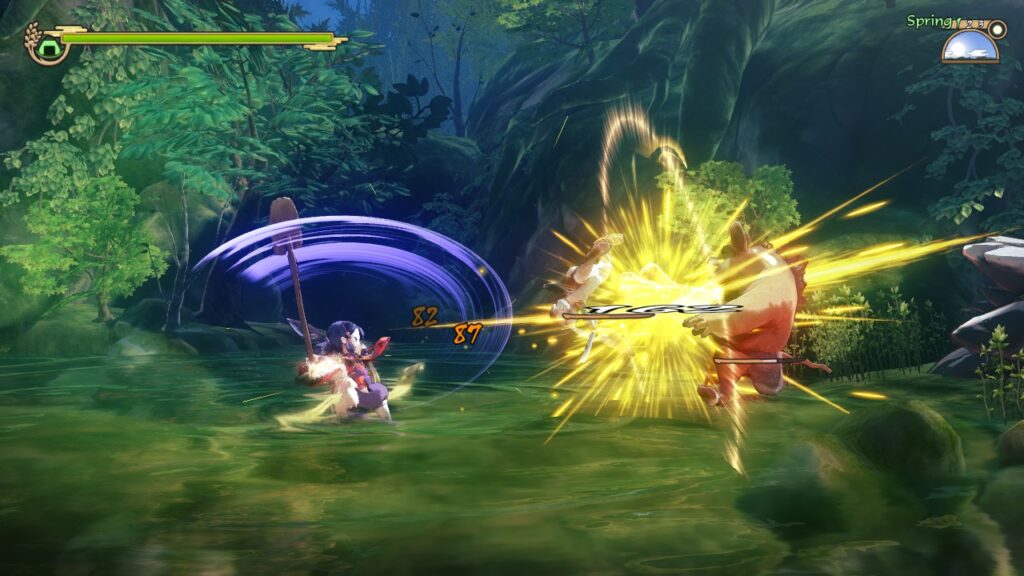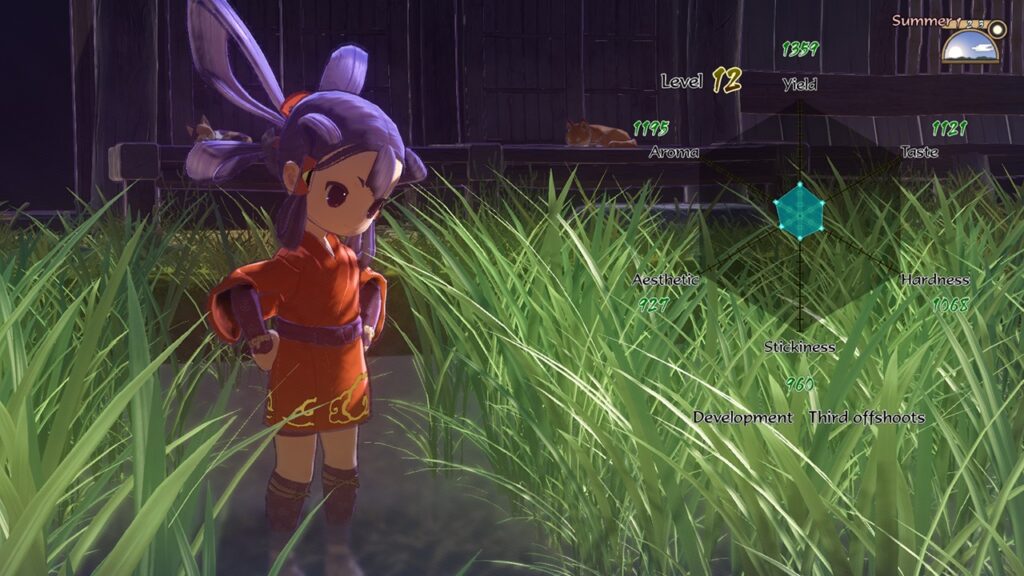
Developer: Edelweiss
Publisher: Marvelous, XSEED
Platform: Switch, PS4, PC
Tested on: Switch
Sakuna: Of Rice and Ruin – Review
Ever since the launch trailer for Sakuna: Of Rice and Ruin debuted at E3 2019, people have been eagerly anticipating the launch of Edelweiss’ Japanese mythology-inspired game. With its appealing visual design and a unique gameplay blend of action platforming and farming simulation, Sakuna seems to have all the right elements to become a cult classic. Now that the wait is finally over, does Sakuna deliver on those expectations?
Story
Sakuna is the daughter of the goddess of harvest and the god of warriors. She is also your typical spoiled brat who always gets what she desires. Apart from having to make an offer to the divine goddess Kamuhitsuki at the annual festival, Sakuna’s life is without worries. However, when a group of humans manages to sneak into the realm of the gods and eats the rice that was supposed to be that year’s offer, things quickly take a wrong turn. Attempting to stop the humans, Sakuna accidentally starts a fire causing Kamuhitsuki to banish both our heroine and the group of humans to the land of the demons as punishment. Sakuna must now cooperate with her human companions to defeat the demons so that all of them can return to their homeworlds.
Graphics
Aesthetically, you’re looking at one of the best-looking games to have come out recently. This is especially apparent when looking at the character designs, each and every one of them oozing with personality, and we have no doubt that it’s these that will draw in a large part of the game’s potential audience. Anyone familiar with Muramasa: The Demon Blade will certainly see similarities between Sakuna and the cult classic, but that’s not a bad thing as the aesthetics just work so well.
Performance-wise, things are slightly different, in the Switch version at least. The game does push the Switch somewhat, resulting in some blurry and muddy textures here and there, as well as some minor flickering issues when it comes to the game’s shadows. However, we’re really nitpicking here as the overall performance doesn’t detract from the gameplay experience. Edelweiss has opted for performance over visual fidelity and the game’s framerate is stable, which is not an easy feat given the amount of on-screen action during the more intense platforming sections.
Sound
Not only does Sakuna feature a considerable amount of voice acting, but you’ll be able to enjoy the game with either an English-language voice cast or their Japanese counterparts. Admittedly, while what we heard from the English version featured good performances, we opted for the Japanese voice cast instead, as we felt the English language version was a bit too Americanized for the setting of the game. If anything, the game is worth picking up for the soundtrack alone, which features no less than 42 original tracks from composer Hiroyuki Oshima. These perfectly capture the flow of the seasons as well as the atmosphere you’d expect from a game inspired by Japanese mythology.
Gameplay
Equal parts 2D action platformer and farming simulator, Sakuna masterfully blends two genres in a unique way. The farming is intrinsically tied to Sakuna’s performance in the action-oriented platforming stages of the game. Farming takes place at the old house of Sakuna’s mother, which serves as an overworld hub. The human characters turn the old house into their temporary homestead, and it’s from here that they will also get involved to aid Sakuna in her plight. The most prominent character is Tauemon, who will teach you how to farm rice. As the title of the game implies, rice is a key ingrediënt and taking good care of your crops will produce a more bountiful harvest allowing you to take full advantage of Sakuna’s abilities. Rice farming involves not only your typical and admittedly repetitive seeding and tilling mechanics, but also careful management of how much water you’ll use on your rice field, with rainfall being an important factor. There’s a surprising amount of depth to growing rice and taking care of your field feels rewarding as it affects so many other areas of gameplay as well.
Apart from rice, other resources are gathered from the platforming stages where Sakuna fights against demons. You’ll not only be able to gather these from killing enemies but also from ore deposits and the like, which are scattered throughout the stages. In case Sakuna is defeated, she’ll lose any resources gathered up to that point in the stage, but if you are just playing a stage to farm resources, you can actually quit and return to the farm at any point to drop off your harvest. An interesting addition to the mechanics here is that any ingredients gathered will only have a limited shelf life before they begin to rot and become unusable. This means that you’ll have to carefully manage your inventory and that you can’t just hoard tons of rare ingrediënts. Luckily, you’ll eventually be able to have the character of Myrthe preserve foods to prevent them from spoiling. While this solves the headache of ingrediënts going to waste, this still involves inventory management as you’ll need to ask her to do so manually. Farmed resources can be used to make dinner, which allows you to apply health and stat boosts to Sakuna. Dinner is an essential mechanic in the game, as Sakuna will need to eat regularly to prevent becoming too exhausted to take on demons.
There is a map that allows you to choose where you’ll want Sakuna to explore and fight demons. At the beginning of the game, available areas are limited of course, but not only do new areas open up as you progress through the game, but there is also an incentive to revisit certain areas as they expand based on the side objectives that each stage offers, based on Sakuna’s exploration level. This encourages you to replay stages without feeling too intrusive or repetitive as each visit adds something new. Additionally, the side objectives are varied enough to allow you to focus on different ways to play through each stage. You can of course clear multiple objectives in a single run, but it’s likely that you’ll need to change your setup to clear all of them. Clearing these objectives will increase Sakuna’s exploration level, which opens up new areas. There is a bit of a cyclic nature to the exploration mechanics and they are well balanced overall.
That cyclic nature is a bit of a recurring theme with Sakuna’s gameplay simply because of how well the farming mechanics and the platform mechanics mesh together. We could go on for hours about the finer details and subtle strategies involved with getting the most out of Sakuna, but it all boils down to this: exploring and fighting demons rewards you with resources, which you can then use to improve your farming, which subsequently will make Sakuna stronger, which will then allow her to take on more demons, rinse and repeat. It’s an incredibly well-crafted system. Then there are the boss fights, which are varied and often involve changing your strategy. More often than not, if you can’t defeat a boss, rather than grinding and levelling up, you can simply return with a different strategy and take care of them easily. This brain over brawn philosophy fits both the theme of the game and makes Sakuna a stand-out game.
There are still a ton of other mechanics and unlockable abilities we haven’t even gotten round to yet, which only serves as a testament to how much there is to do in this game. You’ll be able to dive into smithing, unlock new farming skills that go beyond stat increases and actually add new features, such as a grid that allows you to plant your seeds in a more optimal way. Thankfully, the gameplay eases you into these, and the game manages to never feel overwhelming. Exploration is rewarded, as some features aren’t even apparent on a regular playthrough and you’ll actually have to stumble upon them in order to start using them. This approach means the game constantly surprises you and really shows how many layers there can be to a game that has a relatively simple premise.
Conclusion
Sakuna is a fantastic game that neatly hybridizes two genres that couldn’t be much farther apart from one another. The amazing character designs and beautiful soundtrack further elevate a game that offers solid gameplay with a decent amount of strategic depth that will keep you occupied for dozens of hours. Although the game might not appeal to a mass audience, we expect this one to become a niche classic that will be fondly remembered for years to come in the same vein as Okami or Muramasa: The Demon Blade, and we highly recommend picking this one up.
Sakuna: Of Rice and Ruin - Review,1 Comment
Leave a Reply
You must be logged in to post a comment.










[…] looked at unlikely video game genre combinations in the past such as Sakuna, which married platforming gameplay with a farming sim, or the Voice of Cards games, which […]